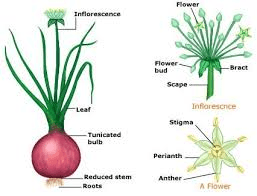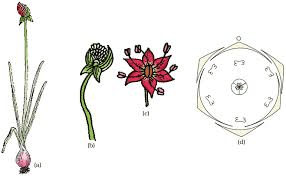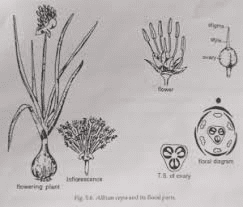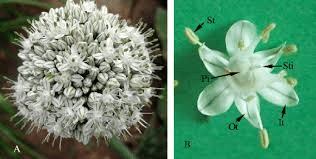Onion stamens, the male reproductive organs of the onion flower, play a pivotal role in the plant’s reproductive process by producing and releasing pollen. Each stamen typically consists of a filament and an anther, where the pollen is produced. In onions, the stamens are often found surrounding the central pistil and are crucial for the fertilization process that leads to seed production.
Structurally, onion stamens are composed of slender filaments that support the anthers at their tips. The filament is a stalk-like structure that elevates the anther to an optimal position for pollen dispersal. This positioning is crucial for maximizing the chances of pollination. The anther itself is a bilobed structure that contains pollen sacs, or microsporangia, where pollen grains are developed. The outer layer of the anther, called the epidermis, protects the developing pollen grains inside.
The process of pollen development, or microsporogenesis, occurs within the anther. Inside the pollen sacs, diploid microsporocytes undergo meiosis to produce haploid microspores. These microspores then undergo mitosis to develop into mature pollen grains, each containing two sperm cells necessary for fertilization. The structure and development of pollen grains are vital for ensuring successful fertilization when they come into contact with the female reproductive organs of another flower.
The anthers of onion stamens release pollen through a process called dehiscence. This involves the splitting open of the anther to expose the pollen grains, which can then be carried away by wind or pollinators. Onions, like many other flowering plants, rely on external agents such as insects or wind for the transfer of pollen. The design of the stamens, including their height and orientation, is adapted to enhance the efficiency of this transfer process.
From a functional perspective, the stamens are critical for genetic diversity in onion populations. By producing and dispersing pollen, stamens enable cross-pollination between different plants, which leads to the mixing of genetic material. This genetic recombination is essential for the adaptability and resilience of the species, allowing onions to thrive in diverse environments and under various conditions.
Onion stamens also have a role in signaling to pollinators. The presence of stamens, along with petals and other floral structures, can influence the behavior of pollinators. For instance, the visual appearance and spatial arrangement of stamens can guide pollinators towards the anthers, ensuring that they come into contact with the pollen. In some cases, stamens may produce scents or nectar that further attract pollinators, enhancing the chances of successful pollen transfer.
Ecologically, the function of onion stamens in pollination and reproduction supports the broader ecosystem. By contributing to the production of seeds, stamens ensure the continuation of the onion plant lifecycle. These seeds not only propagate the species but also provide food and habitat for various organisms, thus playing a role in maintaining ecological balance.
Onion stamens are integral to the reproductive success of the onion plant. Their structural components, including the filament and anther, facilitate the production and release of pollen. Through the processes of pollen development and dehiscence, stamens ensure the transfer of genetic material necessary for fertilization. By enabling cross-pollination and genetic diversity, onion stamens contribute to the adaptability and resilience of the species. Their role in attracting and guiding pollinators further underscores their importance in the plant’s reproductive strategy and ecological contribution.
The Economic Importance and Uses of Onion Stamens

1. Nutritional Supplements: Onion stamens contain beneficial nutrients that can be used in dietary supplements.
2. Natural Dyes: They can be utilized to create natural dyes for textiles, providing an eco-friendly alternative to synthetic dyes.
3. Antimicrobial Agents: Onion stamens have antimicrobial properties, making them useful in natural preservatives for food products.
4. Animal Feed: They can be processed into feed for livestock, adding nutritional value to animal diets.
5. Fertilizers: Onion stamens can be composted to create organic fertilizers, enhancing soil health for agriculture.
6. Biofuels: Research is exploring the potential of onion stamens in the production of biofuels, contributing to renewable energy sources.
7. Medicinal Uses: Onion stamens are studied for their potential in herbal medicine, offering remedies for various ailments.
8. Cosmetic Products: Extracts from onion stamens can be used in cosmetics for their skin-soothing properties.
9. Food Flavoring: They can be dried and ground into a powder to add flavor to various culinary dishes.
10. Pest Repellent: The strong odor of onion stamens can be used to create natural pest repellents for gardens and crops.
11. Biodegradable Packaging: They can be processed into biodegradable packaging materials, reducing plastic waste.
12. Paper Production: Onion stamens can be utilized in making eco-friendly paper products.
13. Wastewater Treatment: They have properties that can aid in the filtration and treatment of wastewater.
14. Antioxidant Sources: Onion stamens are rich in antioxidants, which can be extracted for health supplements.
15. Plant Growth Regulators: They can be processed to create natural growth regulators for agricultural use.
16. Dietary Fiber: Onion stamens are a good source of dietary fiber, which can be added to various food products.
17. Enzyme Production: They can be used in the production of certain enzymes for industrial applications.
18. Traditional Remedies: In some cultures, onion stamens are used in traditional remedies and healing practices.
Read Also: 10 Medicinal Health Benefits of Tabernaemontana pachysiphon (Smoothfruit Cornettree)
The Products and By-products That Can Be Derived From Onion Stamens

1. Nutritional Supplements: Extracting vitamins and minerals from onion stamens for health supplements.
2. Natural Dye: Using onion stamens to produce a natural dye for fabrics and textiles through boiling and soaking processes.
3. Antimicrobial Agents: Creating natural preservatives for food by extracting antimicrobial compounds.
4. Animal Feed: Drying and grinding onion stamens to add to livestock feed.
5. Organic Fertilizer: Composting onion stamens to produce nutrient-rich organic fertilizer.
6. Biofuel: Processing onion stamens through fermentation to produce bioethanol.
7. Herbal Medicine: Extracting active compounds for use in natural remedies and treatments.
8. Skincare Products: Formulating creams and lotions with onion stamen extracts for skin benefits.
9. Culinary Powder: Drying and grinding stamens into a fine powder for use as a spice.
10. Pest Repellent: Creating a spray by infusing onion stamens in water to repel insects.
11. Biodegradable Plastics: Developing packaging materials from onion stamen fibers.
12. Eco-friendly Paper: Processing onion stamens into pulp for paper production.
13. Water Filter: Using onion stamens in the creation of natural filtration systems for water treatment.
14. Antioxidant Extracts: Extracting antioxidants for use in health supplements.
15. Plant Growth Stimulants: Creating natural growth enhancers for plants from onion stamens.
16. Fiber Supplements: Adding processed onion stamens to dietary fiber products.
17. Enzyme Production: Cultivating enzymes from onion stamens for industrial use.
Read Also: Anemone Flowers – All you need to know
Frequently Asked Questions (FAQ’s) About Onion Stamens

1. What are onion stamens?
Onion stamens are the male reproductive parts of the onion flower, often discarded but rich in beneficial compounds.
2. How can onion stamens be used in cooking?
They can be dried and ground into a powder to add flavor to soups, stews, and other dishes.
3. Are onion stamens safe for consumption?
Yes, they are safe and can be used in various culinary and medicinal applications.
4. Can onion stamens be used in skincare?
Yes, extracts from onion stamens can be used in skincare products for their soothing properties.
5. How do onion stamens contribute to sustainability?
They can be used to create biodegradable products, reducing environmental waste.
6. What nutritional benefits do onion stamens offer?
Onion stamens are rich in vitamins, minerals, and antioxidants, making them a nutritious addition to diets.
7. Can onion stamens be used as animal feed?
Yes, they can be dried and added to livestock feed as a nutritious supplement.
8. How are onion stamens used in traditional medicine?
In some cultures, they are used in remedies to treat various health issues due to their medicinal properties.
9. What industrial applications do onion stamens have?
They can be used in biofuel production, wastewater treatment, and enzyme production.
10. Are there any environmental benefits to using onion stamens?
Yes, using onion stamens in various applications reduces waste and promotes eco-friendly practices.
Read Also: How to Make Money from Computer Recycling

